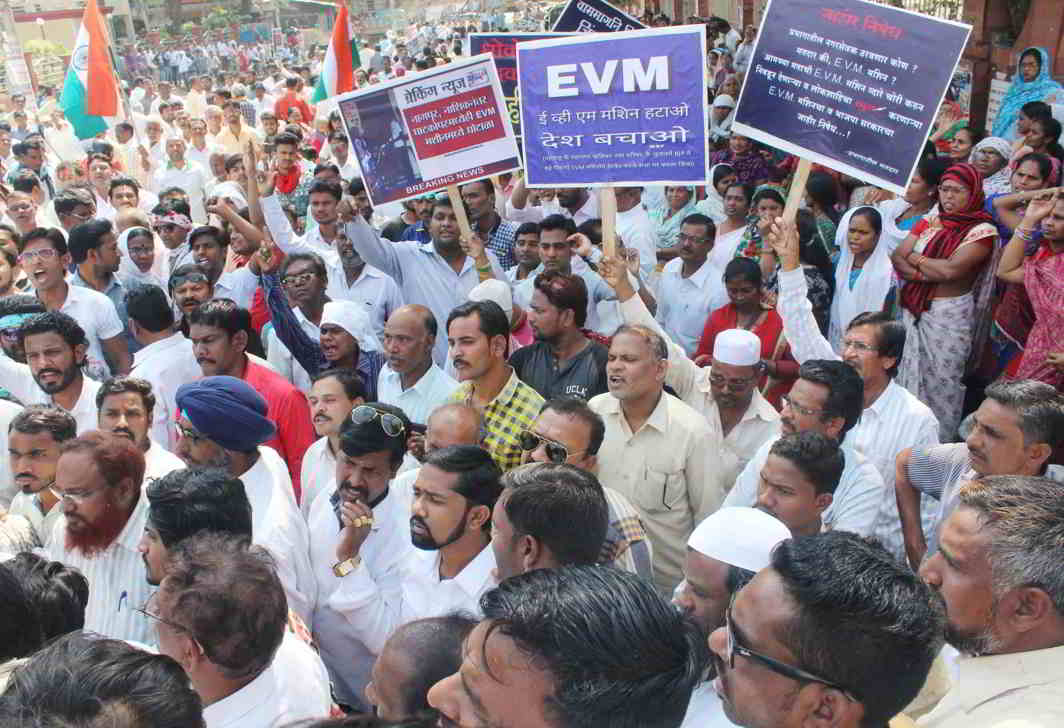Can EVMs be manipulated? That’s the question Mayawati and the BSP posed, post-UP assembly elections, though the govt maintains that is not so

~By Parsa Venkateshwar Rao Jr
A Supreme Court bench comprising Chief Justice JS Khehar, Justices DY Chandrachud and Sanjay Kishan Kaul has on March 24 issued a notice to the Election Commission of India on a petition filed by lawyer ML Sharma that electronic voting machines (EVMs) can be tampered with.
The petition also said that the voting process must be carried through the ballot paper as it was done earlier. The Court asked the EC to reply within four weeks.
Interestingly, Dr Subramanian Swamy, Bharatiya Janata Party member of the Rajya Sabha, was one of the few to point to the unreliability of EVMs and suggested the remedy of a paper trail in 2012. On October 8, 2013, Justices P Sathasivam and Ranjan Gogoi directed the Election Commission to adopt the Voter Verifiable Paper Audit Trail (VVPAT) on the petition filed by Dr Swamy among others.
Earlier in the week, there was a two-day, six-hour short duration discussion on electoral reforms in the Rajya Sabha which focused on EVMs and the possibility of them being hacked and manipulated. The context was the February-March seven-phase Uttar Pradesh assembly election, and the Bharatiya Janata Party (BJP) winning 325 of the 403 seats
The suspicion that there could be something wrong with the EVMs came from the losers, especially the BSP and its leader, Mayawati, when the UP election result was announced on March 11. The party’s member in the Rajya Sabha, Satish Chandra Mishra, posed the issue in stark terms, carrying forward his leader’s views. But Mishra was not alone. Anil Desai of the Shiv Sena made clear his party’s misgivings about EVMs.

In his reply to the debate on March 23, Minister of Law and Justice and Electronics and Information Technology Ravi Shankar Prasad blamed the BSP and other Opposition parties for being bad losers, and for raising questions about EVMs in their hour of defeat. He pointed out that the BSP did not raise the issue when it won the UP assembly election in 2007, and neither did the Samajwadi Party when it won the election in the state in 2012.
Minister of Law and Justice and Electronics and Information Technology Ravi Shankar Prasad blamed the BSP and other Opposition parties for being bad losers, and for raising questions about EVMs in their hour of defeat.
VIRTUES OF EVMs
Prasad was quite eloquent in defending the functioning of EVMs and singing praises of the machine. Two of the virtues of the EVM he mentioned were that ever since it was used in elections beginning 2004, the old menace of booth capturing had ended, and “invalid votes” which added to a big total in elections have now disappeared.
Curiously enough, to defend the use of EVMs, he said that it was being used in Brazil, Venezuela, Mongolia, Bhutan and the Philippines. Opposition leaders pointed out that major democracies such as the US, Germany and France still use the ballot paper. Prasad shot back saying that the Opposition should get rid of its inferiority complex and trust the Indian scientists who came up with the EVM and set an example to the rest of the world.
He, however, issued many clarifications about the EVM. He said it was manufactured by public sector units—Bharat Electronics Limited and the Electronics Corporation of India. He assured the House that whenever EVMs are manufactured, they would be done only by a PSU. He said that even the Election Commission had insisted that production of EVMs should be with a PSU. He also clarified that the EVM was a self-contained machine and not linked to the internet or any other device. Therefore, it cannot be manipulated from outside or hacked.
Where Prasad went soft and partially silent, and where Opposition leaders, including Mishra, struck home was with regard to the Voter-Verified Paper Audit Trail (VVPAT), which is to be attached to the EVM. This helps in confirming that when a voter has pressed a button on the EVM, his vote went to the candidate he voted for. There is a deeper moral issue at stake here. The voter has the right to know that his vote did not go anywhere other than to the person it was intended for. If the voter has a doubt, the VVPAT will help clarify.
Mishra and the leader of the Opposition, Ghulam Nabi Azad, pointed out that in its October 2013 direction, the Supreme Court had asked the Election Commission to induct VVPATs in a phased manner. Azad said the Chief Election Commissioner (CEC) had written six letters to the government for funds for VVPATs, and that in desperation, he went to the unusual extent of writing to the prime minister in February. It was underlined that the CEC, a constitutional authority, always writes to the President and never to the PM, and there was a sense of desperation when the CEC wrote to the PM directly.
If in the last three years, only 30,000 VVPATs were manufactured, it would take 160 years to produce the required number.
SHORTAGE OF VVPATS
Prasad made it clear that the EC insisted that only a PSU should manufacture the VVPAT. He pleaded that money was not the issue, but the production capacity of the PSUs. There are now 30,000 VVPATS, and the required number is 16 lakh, which is the number of EVMs in service. Mishra said that if in the last three years only 30,000 VVPATs were manufactured, it would take 160 years to produce the required number. The people of this country cannot wait for 160 years, he remarked.
The debate remained purely political and even partisan as it was bound to be. So, some of the general questions that needed to be asked about the functioning of EVMs and the deeper questions of the fairness principle should not be ignored. It can be argued and convincingly too that the EVM is efficient and has helped reduced crude rigging through the capture of booths and ballot boxes of earlier elections. But it cannot be ignored that there could be glitches in EVMs as there could be in any machine, and that it could mix up votes. The paper trail envisioned through the VVPAT helps in checking this.
Prasad is certainly right when he points out that the EVM has helped make the Indian election process fair and efficient, but he and the BJP seem blind to the possibility of malfunctioning of the machine. Instances of EVMs showing more votes cast than the number of voters in a particular booth cannot be brushed aside as loser’s gripe. EVMs need vigilant monitoring. The EVM cannot ensure fair elections. It is the people, the EC and political parties who have to do that.


